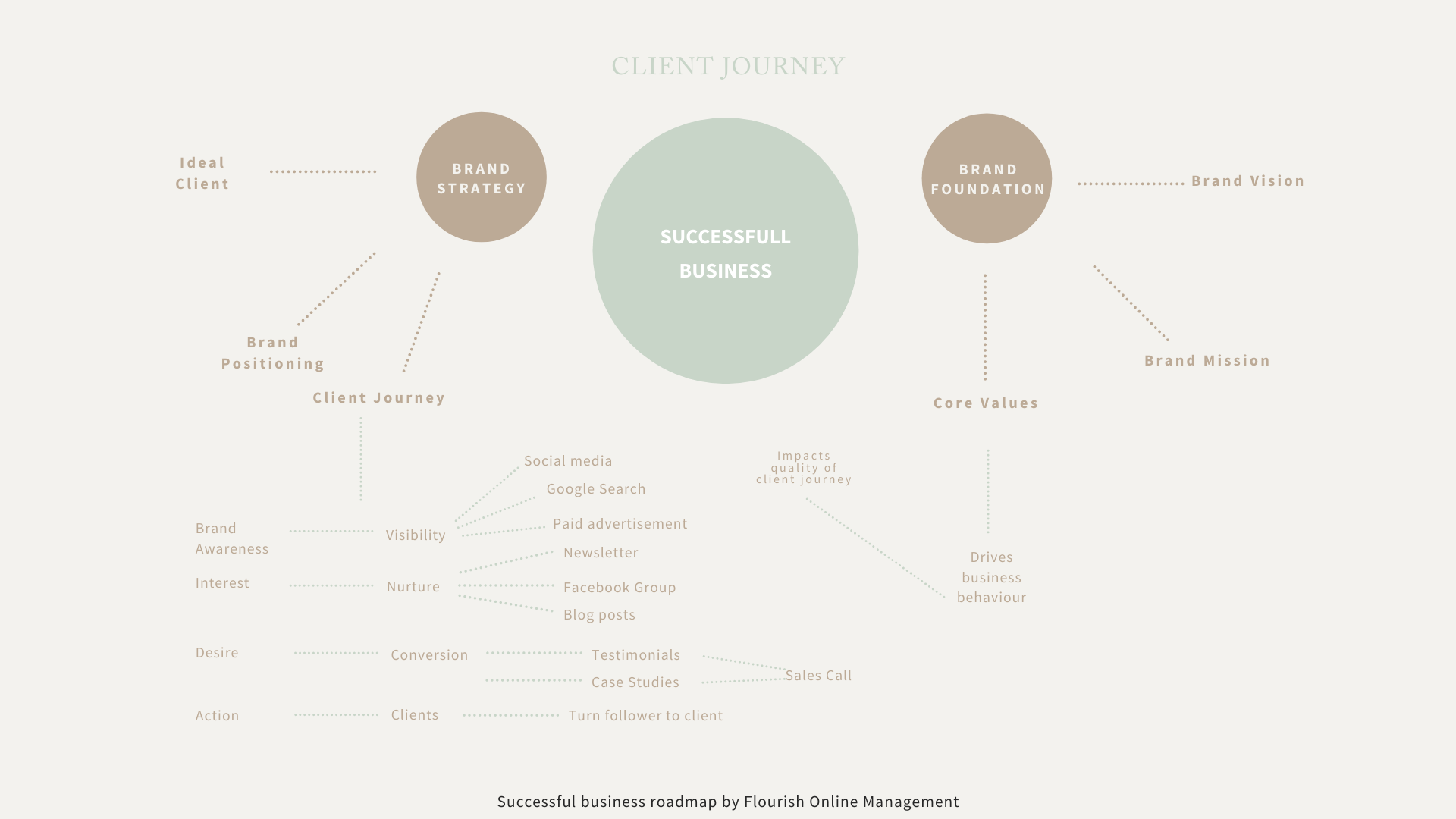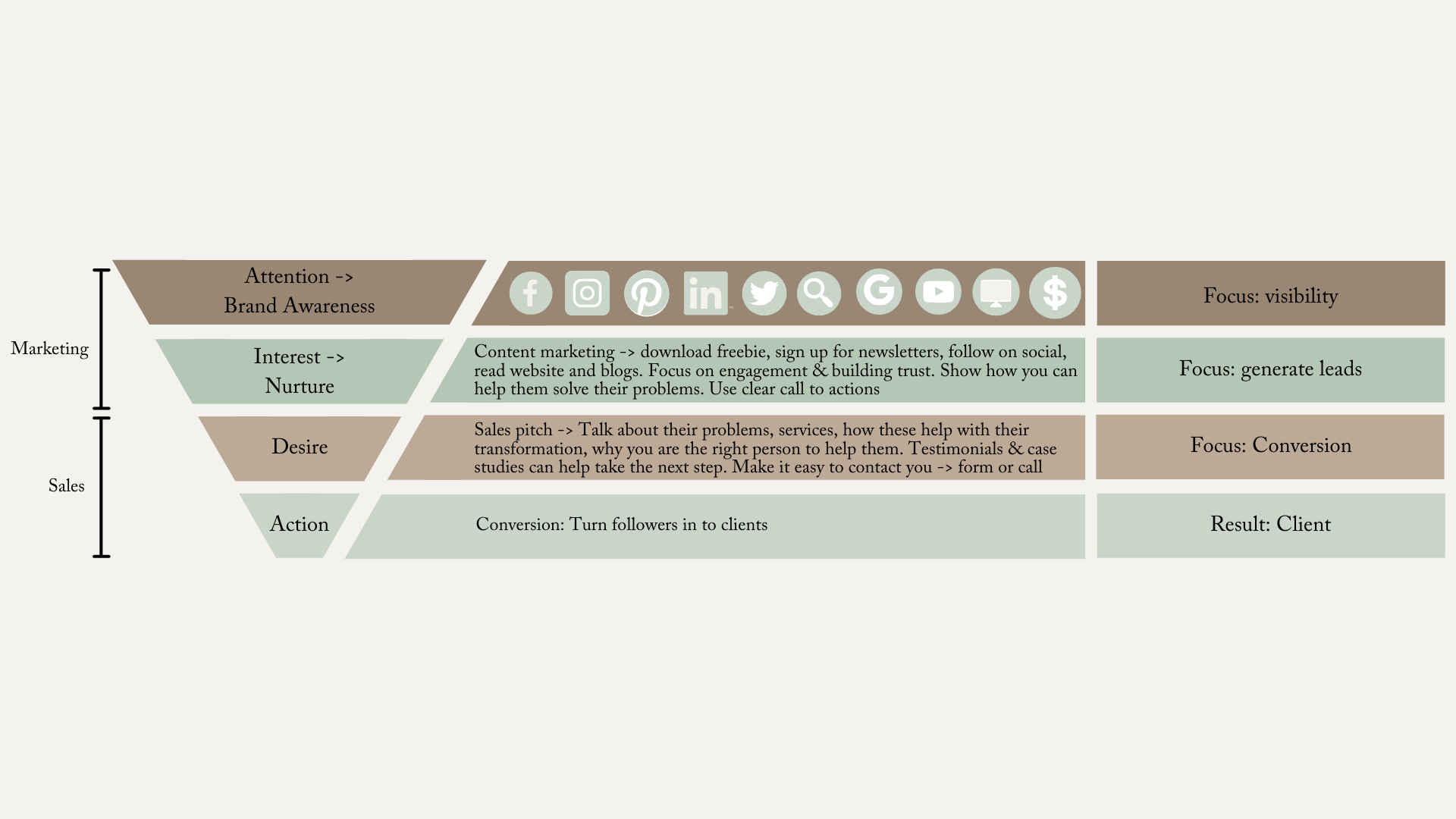The 4 stage journey all clients take before working with you
So you are spending a lot of time on your marketing because well, you need clients. And while scrolling on Facebook and Pinterest is fun, you’re there for a reason. Your business needs clients.
And while some business makes getting clients look really easy or that the clients just come running to them, it’s more likely you need to work HARD to get clients. Right?
So let’s talk about the customer journey and how you can go from a potential client seeing you for the first time to the working with you.
But first things first. What is the customer journey?
Survey monkey explains it like this: The customer journey is the complete sum of experiences that customers go through when interacting with your company and brand. Instead of looking at just a part of a transaction or experience, the customer journey documents the full experience of being a customer.
This could be seeing a pin of your latest blog post on Pinterest, a comment from you in a Facebook Group, reading your newsletter or buying a passive product.
In a customer journey, you literally start mapping out the journey a client takes from first interaction till them working with you. Think about where they can see you for the first time, then what can they do if they are interested, where can they go when they want to know more about you or your business.
Just like I mentioned above that you are not on Facebook and Pinterest for fun, all the elements/platforms have a place in your customer journey. Which in turn, has an important place within your brands strategy (like you can see below). Once you become more aware of all the steps in the customer journey and how your clients go from one phase to the next, you can become more intentional in this process. And you guessed right, if you get more intentional and adjusting your communication based on where a potential client is within the funnel, you will see more and more potential clients move to the next phase and in the end become your clients.
You might be thinking that this sounds nice in theory, but you don’t know how to put this in practice.
Enter: the AIDA model
What?
AIDA is a model or funnel that is related to your customer journey. This funnel leads your clients through so that they will develop an emotional reaction to your business also knows as known as know, like and trust. While they go through the funnel, the number of potential clients will decrease (through your messaging) as you will be weeding out the ones that are not right for you or your services.
You might not have heard about this model, but you are probably already doing this to some extend.
So let's look more closely at this model so that you can become more intentional about this. AIDA stands for:
Attention: this first phase of the customer journey is all about brand awareness
Interest: this is after they have seen you for the first and decide they want to know more
Desire: they have got to know your business and are interested in what you have to offer
Action: they go from being a follower to taking action and contacting you
Next to AIDA, there is also the AIDAR model that added another phase into this, and that is Retention. Or you might see Advocate as the last phase. This is where, after working with you, your clients are so happy with what you did that they will refer others to you, talk about you in their social media or come back for more work.
Let’s dive a bit deeper into these phases of the customer journey using AIDA.
Phase 1 of the AIDA model: Attention
As the customer's journey starts at the first point of contact, a potential client has with your business, you start with brand awareness. Think about all the places where a potential client could see you for the first time:
Social media channels: Facebook, Instagram, Linkedin, YouTube etc
Search engines like Google or Pinterest
Paid advertising
Guest on a podcast or guest post
This phase in the customer journey is all about numbers. If more people know about you and your business, more will start to enter the top of your funnel. So the focus here is growing your visibility and attracting the right potential clients through your messaging. The key here is to talk about the problems and struggles of your audience. This will get them ‘hooked’ and they want to know more. This is when they will move to the next part of the funnel.
One thing I want to mention here is that visibility does not mean you need to be everywhere. You need to be where your ideal client is otherwise you are wasting your time. If you don’t know where that is, be sure to have a look at the blog I wrote about researching your audience
Phase 2 of the AIDA model: Interest
At first glance, this potential client liked what you had to say, and they want to know more. It can be that they follow you on social media, sign up for your newsletter, download a freebie or visit your website to find out if what you have to offer is what they are looking for.
Once they are in this phase of the customer journey, they are going to stay because of your content. So the focus here needs to be on engagement & building trust. To do this, you can use different types of content:
Authority: this is educational content that shows your expertise
Story: this where you show more about yourself. You can tell your history, what you ran into when building your business, give them a feel of what it would be like to work with you.
Evidence & social proof: besides showing your expertise yourself, it is so important to let others that have worked with you tell potential clients how amazing you are. You can use testimonials for this, but you could also think about case studies.
This is a phase where a lot of potential clients stay. Some move through this in a couple of days, but it could also be months before they are ready to move to the next phase.
Phase 3 of the AIDA model: Desire
They have got to know your business and are interested in what you have to offer. So this is where it goes from marketing to sales. They are interested, but the job is not done. In this phase of the customer journey, it is key you show them how your services or products can help them with their problems. So talk about the transformation that you offer and why you are the right person to help them.
For your content in this stage in the customer journey, think about the objections your potential client might have. What could be something that is holding them back from buying from you? Is this the investment, are they unsure they will reach the results they are hoping for, is it the time they need to invest, do they need to know more about how you work? Once you have established this, you can write social posts or blogs about these topics to help lower the barrier for them.
As an example: I have blogs about my brand and website design services that explain the process, about what a client can expect from a consultation call, what they need to know before working with a designer. This all helps them to get to know you and your processes, it will take away a lot of their questions and doubts because let’s face it, it’s scary to invest money for your business. The more they know upfront, the more likely they are to go to the next phase.
Phase 4 of the AIDA model: Action
Here they go from being a follower to taking action and contacting you. So this is all about having call to actions in your content and on your website to move them to this next phase. And, don’t forget to make it easy for them to contact you via a contact form or consultation call that can be booked right on the website.
OK, so I know the 4 stages of the customer journey, Now what?
Ok, so you made an overview of all the steps your clients are currently taking to become your client think about your conversion rates. How many of them actually move through this funnel? If they are not moving through there often, ask yourself in which stage they are getting stuck.
Do they follow you but not sign up to the newsletter? Are your blog posts driving a lot of traffic but are your visitors not going to your services? Do you get traffic to your freebie landing page but they don’t sign?
Then look at this stage and see how you can improve this. So you need to create more visibility by starting with Pinterest or being a guest on podcast? Do you need to promote your freebies more? Improve conversion of the landing page? Add more call to actions or different ones to your website.
Decide what you are going to change, but just keep it at 1 change. If you do more then 1 at a time (as in overhaul your whole landing page instead of changing the CTA) you won’t be able to track which of the changes is actually working better or worse.
So there you have it; the 4 steps of the customer journey. If you are struggling with coming up with ideas on how to improve the journey, one thing that might help is reading this post about your business core values as your core values drive your business. It’s behaviour, and in turn, this can impact the quality of your customer journey.
If you thought this post you might also like:
LOOKING FOR ANYTHING?
Popular items in the shop
FOLLOW ON INSTAGRAM
FAVOURITE RESOURCES
*Below links are affiliate links and I get a small kickback if you use these links to sign up.

























